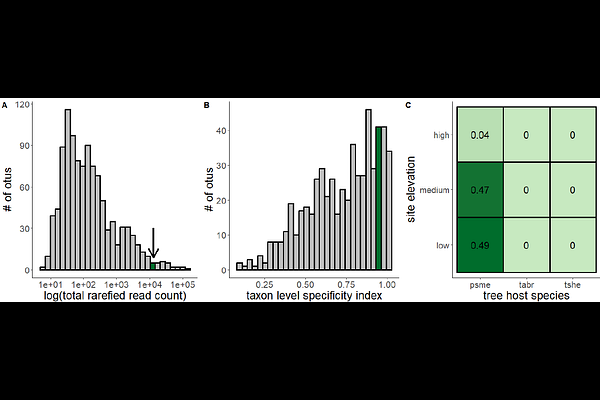Host specificity of fungal functional groups covaries with elevation: implications for intraspecific plant interactions

Host specificity of fungal functional groups covaries with elevation: implications for intraspecific plant interactions
Neat, A. S.; Albornoz, F.; Gervers, K. A.; Busby, P. E.; Jones, F. A.
AbstractPlants of the same species can harbor shared enemies, resulting in indirect, intraspecific competition. When this competition is strong, there are fitness costs associated with growing near a same-species individual, termed Conspecific Negative Density Dependence (CNDD). Host-specific microbial pathogens are known mediators of this type of indirect, intraspecific plant competition, yet how these plant-microbe interactions vary with environmental context is less explored. Further, microbial pathogens and mutualists may jointly contribute to the relative strength of intraspecific competition, yet most studies focus only on pathogens. We use ITS metabarcoding to characterize soil and foliar fungal functional groups associated with individual trees of three dominant conifers in forests where the strength of CNDD is known to be greater at lower elevations relative to higher elevations. We hypothesize that plants found in the mesic low elevation forests accumulate more host-specific fungal pathogens compared to plants found in the more xeric high elevation forests. Conversely, we hypothesize that plants found in the high elevation forests accumulate more host-specific mutualists compared to those found at low elevations. We test these hypotheses by evaluating three metrics of plant-associated fungal functional groups, alpha diversity, relative abundance, and host specificity, that together address the degree to which a plant recruits particular groups. We find the diversity, relative abundance and host specificity of soil fungal pathogens to decrease with elevation. In contrast, we find ectomycorrhizal fungal host specificity, but not diversity or relative abundance, to increase with elevation. Aboveground, we find a key foliar pathogen Nothophaeocryptocus gaeumanii to support our hypotheses as a dominant, and highly host specific pathogen that is enriched at low elevation sites. Our results indicate that across a climate gradient known to negatively covary with CNDD strength, soil pathogens recruitment is most prevalent in the mesic climates and, to a lesser extent, ectomycorrhizal recruitment is most prevalent in the xeric climates. Together these findings suggest that both pathogenic and mutualistic fungal symbionts could contribute to landscape level variation in competitive, intraspecific plant interactions.